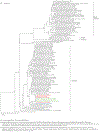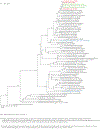Genetic analysis of novel avian A(H7N9) influenza viruses isolated from patients in China, February to April 2013
- PMID: 23594575
- PMCID: PMC6296756
Genetic analysis of novel avian A(H7N9) influenza viruses isolated from patients in China, February to April 2013
Erratum in
- Euro Surveill. 2013;18(16):20459
Abstract
Novel influenza viruses of the H7N9 subtype have infected 33 and killed nine people in China as of 10 April 2013. Their haemagglutinin (HA) and neuraminidase genes probably originated from Eurasian avian influenza viruses; the remaining genes are closely related to avian H9N2 influenza viruses. Several characteristic amino acid changes in HA and the PB2 RNA polymerase subunit probably facilitate binding to human-type receptors and efficient replication in mammals, respectively, highlighting the pandemic potential of the novel viruses.
Conflict of interest statement
Conflict of interest
None declared.
Figures










References
-
- World Health Organization (WHO)/Global Influenza Programme. Cumulative number of confirmed human cases for avian influenza A(H5N1) reported to WHO, 2003–2013 Geneva: WHO: 12 March 2013. Available from: http://www.who.int/influenza/human_animal_interface/EN_GIP_20130312Cumul...
-
- Campbell CH, Webster RG, Breese SS Jr. Fowl plague virus from man. J Infect Dis 1970;122(6):513–6. - PubMed
-
- Centers for Disease Control and Prevention (CDC). Update: influenza activity-United States and worldwide, 2003–04 season, and composition of the 2004–05 influenza vaccine. MMWR Morb Mortal Wkly Rep 2004;53(25):547–52. - PubMed
-
- Editorial team. Avian influenza A/(H7N2) outbreak in the United Kingdom. Euro Surveill 2007;12(22): :pii=3206. Available from: http://www.eurosurveillance.org/ViewArticle.aspx?ArticleId=3206 - PubMed
Publication types
MeSH terms
Grants and funding
LinkOut - more resources
Full Text Sources
Other Literature Sources
Medical
Miscellaneous
